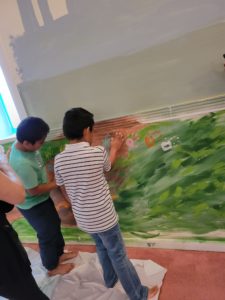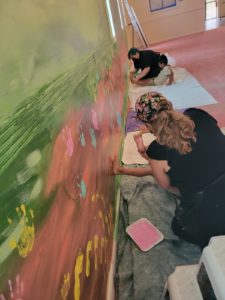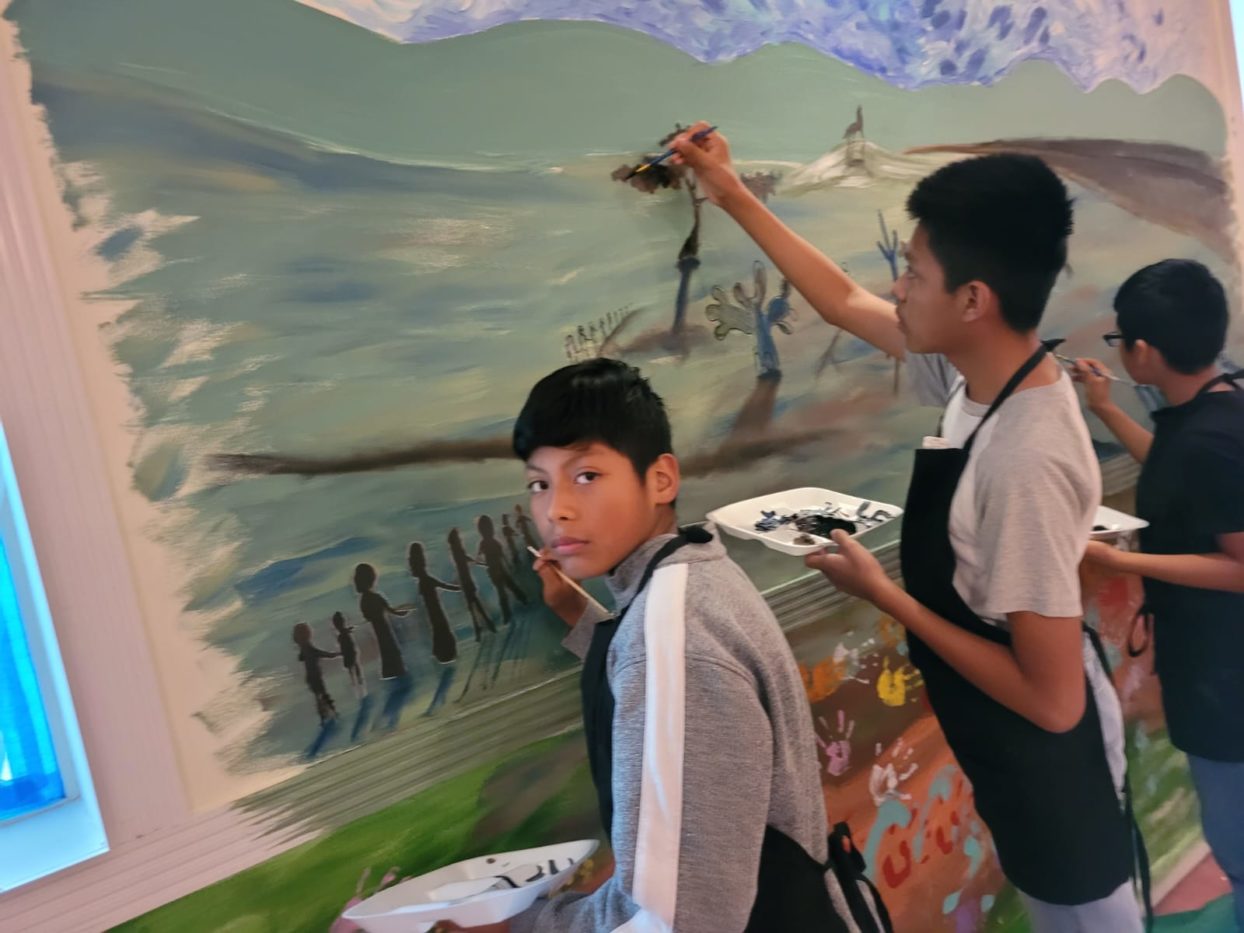Sr. Imelda Quechol’s vacation Bible school taught students to embrace their ‘desert’ journey
By Bill Brewer
Hispanic members of Sister Imelda Quechol’s vacation Bible school class have embraced a wall and what it can represent, although this wall is very different than the one that comes to mind for many people.
 In one of her last activities last summer before she returned to Mexico on assignment, the Missionary Sister of the Sacred Heart of Jesus “Ad Gentes” organized the summer catechetical activity for the Basilica of Sts. Peter and Paul in Chattanooga, where she has served as coordinator of the basilica’s Hispanic community.
In one of her last activities last summer before she returned to Mexico on assignment, the Missionary Sister of the Sacred Heart of Jesus “Ad Gentes” organized the summer catechetical activity for the Basilica of Sts. Peter and Paul in Chattanooga, where she has served as coordinator of the basilica’s Hispanic community.
As part of her instructional exercises, Sister Imelda had the young students paint a mural on a wall of the prayer house where vacation Bible school was held. The mural reflected their and their families’ journeys from their native countries to the United States.
A shared theme of the Israelites’ journey through the desert to the Promised Land was central to the creative process.
During class, an objective was set for the week. Sister Imelda thought it was important to draw a parallel of where the Hispanic community comes from, why they left their native countries, what happened in the “desert,” what happened in the process of crossing the border, and what happened when they arrived in the United States.
 “To me, it was very important that the children understand the family unity and the value of their culture,” Sister Imelda said. “I didn’t want the kids to be embarrassed by their culture. I wanted them to be proud of their culture and to continue sharing their faith and culture with the community. Many of them were separated from their parents at the border. But they were able to reunite with them three to six months later.”
“To me, it was very important that the children understand the family unity and the value of their culture,” Sister Imelda said. “I didn’t want the kids to be embarrassed by their culture. I wanted them to be proud of their culture and to continue sharing their faith and culture with the community. Many of them were separated from their parents at the border. But they were able to reunite with them three to six months later.”
Many Hispanic immigrants who have crossed into the United States from Mexico faced long-term separation from family members at the border, an experience many of them agree was terrifying.
With guidance from an experienced artist, the children summoned all their creativity to give life to their migration vision. Imagery and symbolism were keys to the project.
One of the symbols prominent in the mural is the quetzal, a colorful bird native to Central and South America. Early civilizations considered the quetzal a divine bird and a symbol of goodness and light, something that is sacred and precious.
Another image in the mural is the Quetzalcoatl, or feathered serpent, which symbolizes high authority.
In embracing their talents and sharing them, Sister Imelda believes the students will become as the quetzal is, a free bird with the dignity of children of God.
“They are not foreigners. They are children of God. And they can be as free and beautiful as the quetzal is. The quetzal can be a symbol of Jesus,” she said.
“After that separation and reunion with their family, they must continue living their cultural values and to use the gifts they have received because they are very gifted. They are gifted with music and poetry. And I told them to value and appreciate the sacrifices that their parents made, even with the cost of going through all of this, because they wanted to provide a better life for them,” she added.
Sister Imelda, who is originally from Puebla, Mexico, emphasized that the mural not only depicts families’ efforts to get to the Promised Land—the United States—but also the fact God was with them all along the way as He delivered them to the Diocese of Knoxville.
 “They drew a parallel between being in Guatemala and journeying into the USA with the Israelites traveling to the Promised Land. The kids had to know the stories of their parents, and they had an active role in painting this mural,” she said, noting that most of the children were from Guatemala.
“They drew a parallel between being in Guatemala and journeying into the USA with the Israelites traveling to the Promised Land. The kids had to know the stories of their parents, and they had an active role in painting this mural,” she said, noting that most of the children were from Guatemala.
“In the same way God frees the people of Israel. He accompanied them, taking them by the hand through their most difficult and painful moments. There was a purification period. Despite that time of purification, where they lost members of their families, many were left behind, and they lived through ordeals from the journey. In the end, God was always with them. And they were able to reach their promised land that is the United States. They were freed,” she added.
Children younger and older participated in painting the mural, contributing images of their treks with handprints, footprints, self-portraits, and replicas of symbols from where they were born, many of them faith based.
The wall-sized mural leaves a dramatic impression from a tumultuous, life-altering experience that was done with courage, hope, and faith. The depiction of the Holy Trinity was in God’s will, God’s love, and God’s mercy, according to Sister Imelda, who first served in Chattanooga from 1993-2000 and returned in 2015 to serve until last summer.
The mural was painted inside Holy Cross House, a prayer house for the Basilica Hispanic community. While the Basilica and its Hispanic community own Holy Cross House, they also rent another house of prayer, Immaculate House, that, too, is used by parishioners.
While she wants the children to appreciate what they’ve been through with their families, Sister Imelda also wants them to appreciate where they are now.
“The universal Church works very hard so we can live and reach the Promised Land. That is expressed in the community of our parishes, in the priests and clergy, and in the laity. The kids are not alone. They are part of a community that cares for them. This is their home.
 “These kids have to learn to be grateful because the Church opens its arms wide to welcome them. They have to learn how other institutions in the Church, like Catholic Charities, the Office of Hispanic Ministry, St. Mary’s Legacy Clinic, have been good and also have been called to welcome others and heal others,” she pointed out.
“These kids have to learn to be grateful because the Church opens its arms wide to welcome them. They have to learn how other institutions in the Church, like Catholic Charities, the Office of Hispanic Ministry, St. Mary’s Legacy Clinic, have been good and also have been called to welcome others and heal others,” she pointed out.
Sister Imelda taught them that the Church has welcomed them through these organizations, and she is teaching them to be like that, too.
In keeping with the theme of appreciating those who have helped them in their journey, Sister Imelda said vacation Bible school also recognized vocations as part of its curriculum. People from different vocations, such as priests, seminarians, women religious, deacons, law enforcement officers, and firefighters, shared their experiences in serving the community.
In the mural, the burning bush where God calls Moses was painted to depict how God gives us callings. A similar scene is when Jesus was calling for fishers of men.
Organizing vacation Bible school and the mural were among Sister Imelda’s final activities before she left for Mexico, where she was elected to a leadership position in her congregation.
“I think this work was good. It was very important to let the community know the Church is present and alive through its different people, and that God is present in our lives. It is very important to know that we all need each other’s help. We all need to smile to show that God is present in our lives,” she said.
“The most important achievement of the children at vacation Bible school that I want them to keep in their hearts is that in the same way the quetzal flew so high with the dignity it possesses, those kids have the dignity that God gives them through Jesus as they are made in God’s image. They can share their talents and bear fruit when they are welcoming to others in the community and when they catechize and share love. When they realize how big God’s love is, in spite of their suffering, there will be hope in their hearts,” she added.

